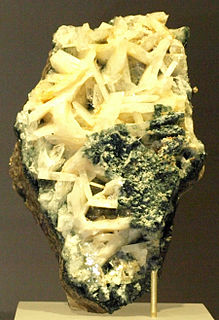
In chemistry, an ester is a chemical compound derived from an acid in which at least one –OH (hydroxyl) group is replaced by an –O–alkyl (alkoxy) group. Usually, esters are derived from a carboxylic acid and an alcohol. Glycerides, which are fatty acid esters of glycerol, are important esters in biology, being one of the main classes of lipids, and making up the bulk of animal fats and vegetable oils. Esters with low molecular weight are commonly used as fragrances and found in essential oils and pheromones. Phosphoesters form the backbone of DNA molecules. Nitrate esters, such as nitroglycerin, are known for their explosive properties, while polyesters are important plastics, with monomers linked by ester moieties. Esters usually have a sweet smell and are considered high-quality solvents for a broad array of plastics, plasticizers, resins, and lacquers. They are also one of the largest classes of synthetic lubricants on the commercial market.

Phosphorus is a chemical element with symbol P and atomic number 15. Elemental phosphorus exists in two major forms, white phosphorus and red phosphorus, but because it is highly reactive, phosphorus is never found as a free element on Earth. It has a concentration in the Earth's crust of about one gram per kilogram. With few exceptions, minerals containing phosphorus are in the maximally oxidized state as inorganic phosphate rocks.

Diagenesis is the change of sediments or existing sedimentary rocks into a different sedimentary rock during and after rock formation (lithification), at temperatures and pressures less than that required for the formation of metamorphic rocks. It does not include changes from weathering. It is any chemical, physical, or biological change undergone by a sediment after its initial deposition, after its lithification. This process excludes surface alteration (weathering) and metamorphism. These changes happen at relatively low temperatures and pressures and result in changes to the rock's original mineralogy and texture. There is no sharp boundary between diagenesis and metamorphism, but the latter occurs at higher temperatures and pressures. Hydrothermal solutions, meteoric groundwater, porosity, permeability, solubility, and time are all influential factors.

Azide is the anion with the formula N−
3. It is the conjugate base of hydrazoic acid (HN3). N−
3 is a linear anion that is isoelectronic with CO2, NCO−, N2O, NO+
2 and NCF. Per valence bond theory, azide can be described by several resonance structures; an important one being . Azide is also a functional group in organic chemistry, RN3. The dominant application of azides is as a propellant in air bags.

Dual-energy X-ray absorptiometry is a means of measuring bone mineral density (BMD). Two X-ray beams, with different energy levels, are aimed at the patient's bones. When soft tissue absorption is subtracted out, the bone mineral density (BMD) can be determined from the absorption of each beam by bone. Dual-energy X-ray absorptiometry is the most widely used and most thoroughly studied bone density measurement technology.
The peroxide process is a method for the industrial production of hydrazine.

Sodium fluoride (NaF) is an inorganic compound with the formula NaF. It is a colorless or white solid that is readily soluble in water. It is a common source of fluoride in the production of pharmaceuticals and is used to prevent cavities.

Hydrazoic acid, also known as hydrogen azide or azoimide, is a compound with the chemical formula HN3. It is a colorless, volatile, and explosive liquid at room temperature and pressure. It is a compound of nitrogen and hydrogen, and is therefore a pnictogen hydride. It was first isolated in 1890 by Theodor Curtius. The acid has few applications, but its conjugate base, the azide ion, is useful in specialized processes.
Renal osteodystrophy is currently defined as an alteration of bone morphology in patients with chronic kidney disease (CKD). It is one measure of the skeletal component of the systemic disorder of chronic kidney disease-mineral and bone disorder (CKD-MBD). The term "renal osteodystrophy" was coined in 1943, 60 years after an association was identified between bone disease and renal failure.
Mineralization may refer to:

Whitlockite is a mineral, an unusual form of calcium phosphate. Its formula is Ca9(MgFe)(PO4)6PO3OH. It is a relatively rare mineral but is found in granitic pegmatites, phosphate rock deposits, guano caves and in chondrite meteorites. It was first described in 1941 and named for Herbert Percy Whitlock (1868–1948), American mineralogist, Curator, American Museum of Natural History, New York City, NY, US.

Quantitative computed tomography (QCT) is a medical technique that measures bone mineral density (BMD) using a standard X-ray Computed Tomography (CT) scanner with a calibration standard to convert Hounsfield Units (HU) of the CT image to bone mineral density values. Quantitative CT scans are primarily used to evaluate bone mineral density at the lumbar spine and hip.
Diimide, also called diazene or diimine, is a compound having the formula (NH)2. It exists as two geometric isomers, E (trans) and Z (cis). The term diazene is more common for organic derivatives of diimide. Thus, azobenzene is an example of an organic diazene.
Digital X-ray radiogrammetry (DXR) is a method for measuring bone mineral density (BMD). Digital X-ray radiogrammetry is based on the old technique of radiogrammetry. In DXR, the cortical thickness of the three middle metacarpal bones of the hand is measured in a digital X-ray image. Through a geometrical operation the thickness is converted to bone mineral density. The BMD is corrected for porosity of the bone, estimated by a texture analysis performed on the cortical part of the bone.
In biology, mineralization refers to a process where an inorganic substance precipitates in an organic matrix. This may be due to normal biological processes that take place during the life of an organism such as the formation of bones, egg shells, teeth, coral, and other exoskeletons. This term may also refer to abnormal processes that result in kidney and gall stones.

Mineralized tissues are biological tissues that incorporate minerals into soft matrices. Typically these tissues form a protective shield or structural support. Bone, mollusc shells, deep sea sponge Euplectella species, radiolarians, diatoms, antler bone, tendon, cartilage, tooth enamel and dentin are some examples of mineralized tissues.

Bone mineral is the inorganic component of bone tissue. It gives bones their compressive strength. Bone mineral is formed from carbonated hydroxyapatite with lower crystallinity.

The conservation and restoration of frescoes is the process of caring for and maintaining frescos, and includes documentation, examination, research, and treatment to insure their long-term viability, when desired.

















